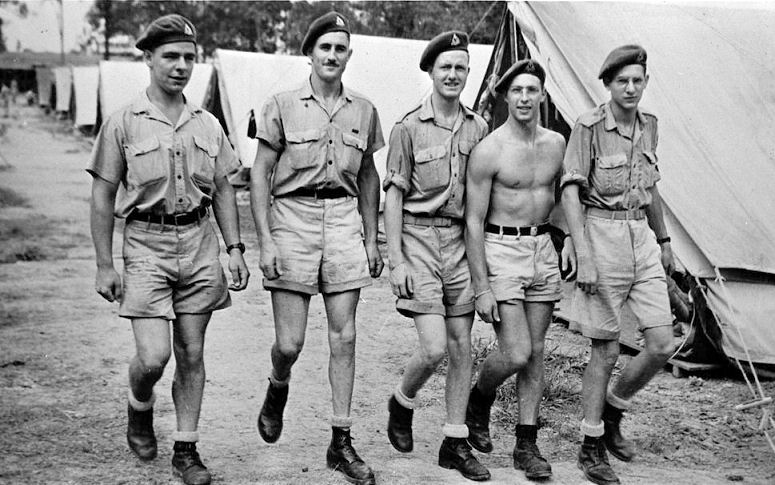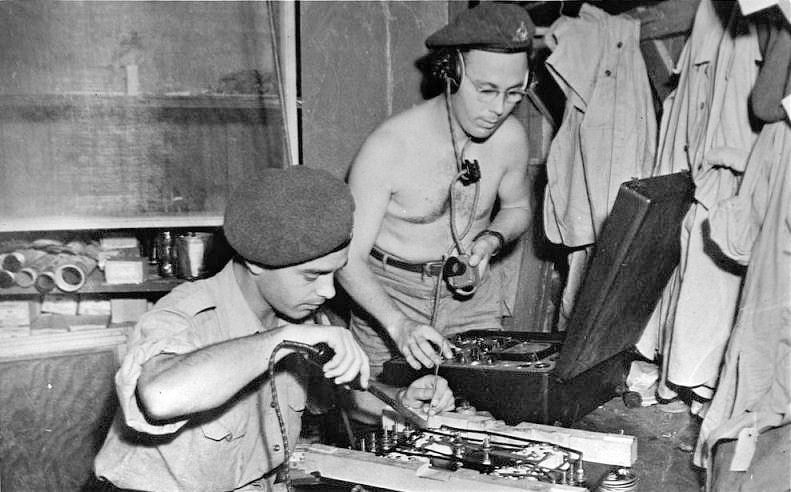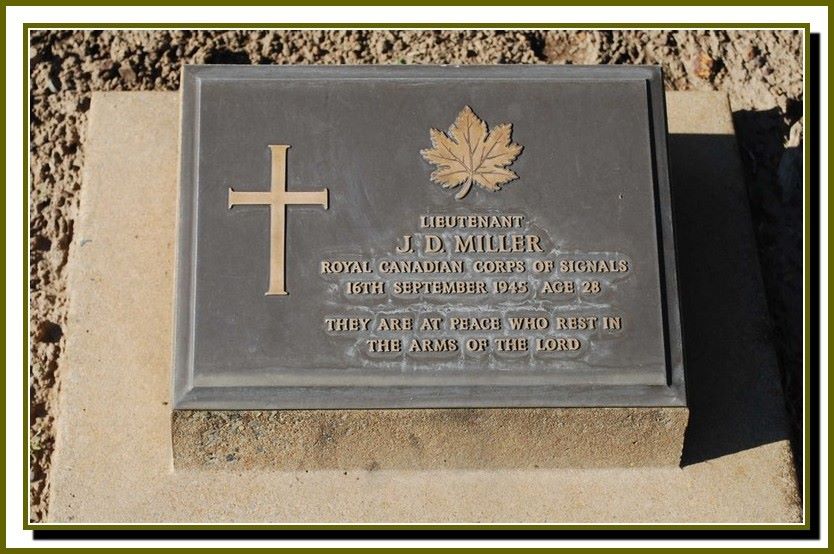NO. 1 SPECIAL WIRELESS GROUP
ROYAL CANADIAN CORPS OF SIGNALS (RCCS)
IN AUSTRALIA DURING WW2
![]()
The Royal Canadian Corps of Signals (RCCS) established "Special Wireless" or "Y work" groups to intercept enemy radio traffic.
On 7 June 1944 the Canadian War Cabinet approved the establishment of a special Signals and Intelligence Unit to be sent to India to intercept Japanese military radio messages. The Commander-in Chief of the Indian Army had requested the establishment of such a group in India in May 1944.
On 1 July 1944, Lieutenant John David Miller was detached from No. 1 Special Wireless Station, Leitrim, Ontario to No.1 (Canadian) Special Wireless Group (1CSWG). Miller, along with Captain H.L. Hall, Capt R.E. March, and Lt. J.H. Legere were the first four members of the new Group.The establishment of No. 1 Special Wireless Group of the Royal Canadian Corps of Signals (RCCS) was approved by the Minister on 19 July 1944.
In late August 1944, the Australian Government requested that No. 1 Special Wireless Group be dispatched to Australia rather than India.
The Signals Section (13 Officers and 278 men) and the Intelligence Section (6 Officers and 39 other ranks) moved to Patricia Bay Camp near Victoria, B.C, in August 1944 for more training and indoctrination and to assemble all of their necessary specialist equipment.
The Intelligence Section was made up of men from No. 1 Discrimination Unit in Ottawa. The Signals section was established using men who had already been working at various Signal Monitoring stations across Canada. They were mostly already trained in the interception of Japanese Code. Approximately 30 additional men were recruited and trained.
No. 1 Special Wireless Group commanded by Lieutenant-Colonel H.D.W, Wethey, left Canada on 20 January 1945 on board U.S.A.T. Monterey. They arrived at Finschafen Harbour in New Guinea on 4 February 1945. They relocated to Hollandia and boarded the hospital ship U.S.A.T. Shawnee on 7 February 1945. They called into Oro Bay on 11 February 1945 and Milne Bay on 12 February 1945. They then headed southwards for Australia where they arrived in Brisbane on 15 February 1945.
They camped at Camp Chermside on the north side of Brisbane during their six and a bit weeks in Brisbane. The Australian Comforts Fund organised weekend outings to interesting locations around Brisbane.
Signalman Dermott Joseph Green (F/5051) drowned during a visit to Maroochydore on 3 March 1945. A funeral service was held at St Joseph's Roman Catholic Church and he was buried at the Woombye War Cemetery, Plot B, Row C, Grave 10.
|
Nambour Chronicle and North Coast Advertiser CANADIAN SOLDIER LOSES LIFE IN SURF After surfing with companions at Maroochydore from about 3 p.m., tragedy came at about 5.30, when Private Dermott Joseph Green, a Canadian serviceman (married), who had only been in Australia a fortnight, was drowned in the surf on Saturday afternoon last. The soldier (26 years of age), born at Novia Scotia (Canada), was the weekend guest of Mr. and Mrs. E. G. Smith, of Buderim Mountain. In company with another Canadian soldier and Mr. and Mrs. Smith's daughter, he had been surfing for some two hours when he was suddenly drawn into a deep gutter,' and being unable to swim found his difficulties accentuated. His companions swam to his assistance, but the undertow had become so strong that all three were in danger of being engulfed. Several times they attempted a rescue, but in the last effort Green slipped from their grasp and disappeared. Others assisted in a search, but the muddy nature of the water added to the difficulties. A little time later Green was discovered in shallower water, and then brought to shore about 15 minutes after he had last been seen. Aided by others and life savers, work of artificial respiration was immediately proceeded with, and a doctor from Mooloolaba summoned. Efforts at resuscitation proved unavailing. Green leaves a wife and two children. The funeral took place to the Palmwoods - Woombye cemetery on Monday, some 27 men and 3 officers of the deceased's unit attending at the graveside. |

Photo:- Library and Archives Canada
Canadian Signalmen in Australia -
Members of a Canadian special wireless group training
for action in the Pacific now stationed in Brisbane, Australia, are cheerful
despite the
hottest March weather in 42 yrs. Shown here are: Signalman R. Montreuil,
Signalman J.G.
Groome, Signalman L. Exelby, Signalman E.A. Lowe and Signalman J. Taylor.

Photo:- Library and Archives Canada
Members of a Canadian Special
Wireless Group, training in Brisbane, Australia, for action
in the Pacific, are cheerful despite the hottest March in 42 yrs. Shown
here testing Canadian
radio equipment in Australia are: Signalman J.P. Trottier, and Signalman
Maywood.

Photo:- Library and Archives Canada
General Sir Thomas Blamey
inspecting Canadian troops on 5 March 1945 on his recent tour of the Southwest
Pacific
area. At the left is Major F.H. Rowland and Lt. Col. H.D.W. Wethey, Commanding
Officer of 1CSWG.

Photo:- Library and Archives Canada
A group of Canadian Army
specialists in Australia, visited Canberra recently. Front row:-
Sgt. W.V. Gavrilloff, Sgt. W.H.C. Holcombe, S/Sgt C.L. Getz Back row: Sgt. J.E.
Lauret,
Sgt. K.W. McKay, S/Sgt G.W. Laycroft, Sgt. E.D. Welland, Sgt. L.M. Williams,
Sgt. C.F. Colvin,
Sgt. R.F. McCallum, Sgt. T. Murray, QMS J.T. Hanes, Sgt W.F. Schrempp.

Photo:- Library and Archives Canada
A group of Canadian Army
specialists in Australia, visited Canberra recently. They were
shown over Parliament House and entertained by Mrs. Davis, wife of the Canadian
High
Commissioner in Australia, Hon. Mr. Justice Thomas Clayton Davis. The Australian
Minister for Repatriation, Hon. Charles William Frost and the Canadian
Military
Attache Col. R.M. Cosgrove, with the men in the courtyard of Parliament House.
No. 1CSWG left Brisbane by train from Exhibition Station on 4 April 1945 headed for Darwin. They arrived in Mount Isa three days later where they spent two and half days unloading their equipment on to trucks. They then departed for Darwin via motor transport and finally arrived in Darwin on 18 April 1945 with the N.T. Force Band playing the Canadian troops into their McMillan's Road Camp.
They immediately started to set up their camp and antennaes were laid out and cable trenches dug. They started their first regular shift on 30 April 1945.
While in Darwin No. 1 Special Wireless Group intercepted an average of 1200 Japanese messages a day. They were assigned to Central Bureau in Brisbane which had its headquarters at 21 Henry Street,, Ascot in Brisbane.
When the war with Japan ended on 15 August 1945, General Douglas MacArthur requested that No. 1 Special Wireless Group continue to operate and intercept diplomatic traffic. The unit ceased operations in Australia on 11 October 1945.
The unit left Darwin on 24 October 1945 headed southwards by motor vehicle, then by train, and then finally by motor vehicles to Sydney where they arrived on 24 November 1945. Some members of the Intelligence Section were sent to New Guinea and Timor and other places to assist at peace negotiations and surrender ceremonies as interpreters. Another 6 men were sere sent to Manilla to be part of the Canadian Repatriation Group. A further 4 men were sent to Japan to be members of the Canadian Recovery Team.
On 6 February 1946, the rest of the Unit were finally embarked on the T.S.M.V. Socotra. They arrived back in Vancouver on 25 February 1946.

Photo:- Doug Tilley
Headstone of Lieutenant John David Miller at Adelaide River Military Cemetery
In October 1999, members of a newly formed Canadian Peace Force sent to Darwin to assist with the problems in Timor, discovered the grave of Lieutenant John David Miller of the Canadian No. 1 Special Wireless Group in the Adelaide River Military Cemetery. Robert Sandow told me that he met some Canadians during their service at the 75th anniversary of the Darwin bombing. Whilst at the Adelaide River Military Cemetery for the service on the following day, the Canadians placed a wreath, not on the Memorial like everybody else, but on the grave of Lt. John David Miller (Grave G.D.3) from their WWII secret wireless station. 28 year old Lt. John David Miller died in 107 Australian General Hospital in Darwin on 16 September 1945 of acute encephalitis whilst the unit was based in Darwin. He was buried at Adelaide River on 18 September 1945. Lt. Miller was the Technical Maintenance Officer and Sports Officer for 1CSWG at the time of his death.
The funeral party comprised 8 members of the Technical Maintenance Section as bearers, 8 Unit officers as pall bearers, the Chief Signal Officer (CSO) of the NT Force, a member of the CSO Staff; two buglers, two drummers, and a firing party of approximately 40 Unit personnel. Chaplain Clayden, Royal Australian Air Force (RAAF) conducted the service.
REFERENCE
"History of the Royal Canadian Corps of
Signals 1903 - 1961"
edited by John S. Moir
"The Invisible War: The Untold Secret Story of Number
One Canadian Special"
by Gilbert Murray
ACKNOWLEDGEMENTS
I'd like to thank Robert Sandow for alerting me of the grave of Lt. J.D. Miller of No. 1CSWG in the Adelaide River Military Cemetery.
I'd like to thank Barry Miller and Doug Tilley for their assistance with this web page.
Can anyone help me with more information?
"Australia @ War" WWII Research Products
|
© Peter Dunn 2015 |
Please
e-mail me |
This page first produced 3 October 2001
This page last updated 03 March 2020